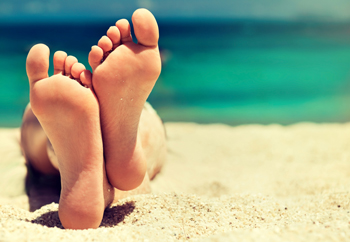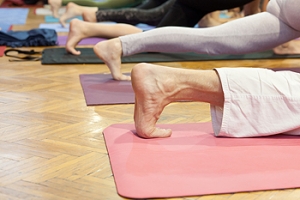
Everyday Foot Care
Our feet are arguably one of the most important parts of the body. When it comes to health and beauty routines, the feet and toenails are usually ignored. You should always practice proper footcare to avoid any fungal infections or ailments that can not only ruin the appearance of your feet, but also cause pain. Ignoring any foot problems could potentially lead to an expensive doctor’s visit.
The most important step in proper foot care is to wash your feet daily. You should wash them with soap and water. Doing this will cleanse your feet of dirt, sweat and bacteria. It is crucial that you clean between the toes and pat your feet dry with a towel afterward. Your toenails are also an important part of the feet and you may find that they get dirtier in the summer when you wear sandals. It is important that you practice proper toenail care in addition to cleaning the rest of your feet. When trimming your nails, you should always trim straight across instead of in a rounded shape. Trimming in a curved shape may lead to ingrown toenails.
Moisturization is also important for foot care, and you should be moisturizing your feet every day. The best way to prevent dry feet is to rub lotion or petroleum jelly on your clean feet at night and put socks over them. In the morning, your feet should be soft and moisturized.
Another crucial step in proper foot care is to wear the right shoes for whichever activity you are going to partake in. In warmer weather, you should wear shoes that allow your feet to breathe. It is best to avoid shoes such as flip-fops that do not provide arch support. Tight shoes may also be harmful, and they may even cause you to develop bunions.
If you plan on taking a shower in a public area, you should be especially careful, so you do not pick up any fungi. Showers are prone to harboring different types of bacteria and fungi. You should always wear shower shoes or flip flops when walking around in locker rooms and public showers. Avoid sharing shoes with other people because this is another way that fungus may be spread.
If you are experiencing any problems with your feet you should speak with your podiatrist to determine the best method of treatment for you.
Podiatrists and Pedicurists
 Podiatrists are doctors who specialize in the foot and ankle and can treat the most severe foot conditions. While conditions like corns, calluses, foot fungus, and cracked heels may seem minor to some, podiatrists offer the best solutions when it comes to fixing them. Pedicurists, on the other hand, are cosmeticians and cannot treat foot ailments. Pedicurists may also not know what a fungal infection like athlete's foot looks like and may therefore be unable to alert you if you have the condition. Despite this, pedicures are a great way to beautify and maintain clean-looking feet. Just ensure that the pedicure salon uses clean instruments, as unclean tools can potentially lead to fungal infections. Be wary of the type of nail polish used by a pedicurist, as certain varieties can be harsh on nails and preserve and hide toenail infections. If the pedicurist cuts skin around the cuticle, this is potentially dangerous and can also lead to infections. Above all, be aware of what is going on in a pedicure salon; remember that pedicurists are not podiatrists and cannot help with foot conditions. If you have an issue with your feet, see a podiatrist for proper care.
Podiatrists are doctors who specialize in the foot and ankle and can treat the most severe foot conditions. While conditions like corns, calluses, foot fungus, and cracked heels may seem minor to some, podiatrists offer the best solutions when it comes to fixing them. Pedicurists, on the other hand, are cosmeticians and cannot treat foot ailments. Pedicurists may also not know what a fungal infection like athlete's foot looks like and may therefore be unable to alert you if you have the condition. Despite this, pedicures are a great way to beautify and maintain clean-looking feet. Just ensure that the pedicure salon uses clean instruments, as unclean tools can potentially lead to fungal infections. Be wary of the type of nail polish used by a pedicurist, as certain varieties can be harsh on nails and preserve and hide toenail infections. If the pedicurist cuts skin around the cuticle, this is potentially dangerous and can also lead to infections. Above all, be aware of what is going on in a pedicure salon; remember that pedicurists are not podiatrists and cannot help with foot conditions. If you have an issue with your feet, see a podiatrist for proper care.
If you are experiencing pain in the feet or ankles, don’t join the stubborn majority refusing treatment. Feel free to contact one of our podiatrists from New York Foot and Ankle. Our doctors can provide the care you need to keep you pain-free and on your feet.
What Is a Podiatrist?
Someone would seek the care of a podiatrist if they have suffered a foot injury or have common foot ailments such as heal spurs, bunions, arch problems, deformities, ingrown toenails, corns, foot and ankle problems, etc.
Podiatric Treatment
A podiatrist will treat the problematic areas of the feet, ankle or lower leg by prescribing the following:
- Physical therapy
- Drugs
- Orthotic inserts or soles
- Surgery on lower extremity fractures
A common podiatric procedure a podiatrist will use is a scanner or force plate which will allow the podiatrist to know the designs of orthotics. Patients are then told to follow a series of tasks to complete the treatment. The computer will scan the foot a see which areas show weight distribution and pressure points. The podiatrist will read the analysis and then determine which treatment plans are available.
If you have any questions please feel free to contact one of our offices located in Franklin Square, Bethpage, Brooklyn, and Massapequa, NY . We offer the newest diagnostic and treatment technologies for all your foot and ankle needs.
What is a Podiatrist?
The branch of medicine that is focused on the treatment, diagnosis, and study of disorders of the lower leg, ankle and foot is referred to as podiatry. Because people often spend a great deal of their time on their feet, many problems in this area can occur. A person seeks help from the field of podiatry when they need treatment for heel spurs, bunions, arch problems, deformities, ingrown toenails, corns, foot and ankle problems, infections, and problems with the foot that are related to diabetes and additional diseases.
To treat problems of the foot, ankle or lower leg, a podiatrist may prescribe physical therapy, drugs, perform surgery, or set fractures. Individuals may also be recommended to wear corrective shoe inserts, custom-made shoes, plaster casts and strappings in order to correct deformities.
When trying to gather information on a patient problem, a scanner or force plate may be used in order to design orthotics. During this procedure, patients are told to walk across a plate that is connected to a computer; the computer then takes a scan of the foot and indicates weight distribution and pressure points. The computer readouts will give the podiatrist information to help them determine the correct treatment plans.
Diagnosis is also provided through laboratory tests and x-rays. Through the foot, the first signs of serious problems such as heart disease, diabetes and arthritis can show up. For example, individuals that have diabetes may frequently have problems such as infections and foot ulcers because they experience poor circulation in the foot area. A podiatrist can then have consultations with patients when symptoms arise. Referrals will then be made to specialists that handle the greater health problems.
Some podiatrists have their own independent, private practices or clinics where they have a small staff and administrative personnel. Many podiatrists work within group practices. They usually spend time performing surgery in ambulatory surgical centers or hospitals, or visit patients in nursing homes. Podiatrists typically spend between 30 to 60 hours of week working. Some podiatrists specialize in public health, orthopedics, surgery, or primary care. Other fields include specialties in geriatrics, dermatology, pediatrics, diabetic foot care and sports medicine.
Some podiatrist specialists complete extra training in the area of foot and ankle reconstruction that results from the effects of physical trauma or diabetes. There are also surgeons that perform surgery of a cosmetic nature to correct bunions and hammertoes.
What is Metatarsalgia?
 Metatarsalgia refers to pain that is in the ball of the foot. This term refers to the metatarsal bones that are in this area, and the pain is often a result of repetitive bursts that occur in this part of the foot and eventually overload the metatarsals. Pain over the top and sole of the foot between the 2nd and 4th toes is the most common sign of metatarsalgia. Often, this pain is worsened by pushing off while walking or running. If you are experiencing pain in the forefoot that may be metatarsalgia, it is important to consult with a podiatrist. A podiatrist will check to make sure there is no other damage in the area and prescribe a treatment method. Treatment usually starts with rest and icing the foot, and may include medicine or orthotics.
Metatarsalgia refers to pain that is in the ball of the foot. This term refers to the metatarsal bones that are in this area, and the pain is often a result of repetitive bursts that occur in this part of the foot and eventually overload the metatarsals. Pain over the top and sole of the foot between the 2nd and 4th toes is the most common sign of metatarsalgia. Often, this pain is worsened by pushing off while walking or running. If you are experiencing pain in the forefoot that may be metatarsalgia, it is important to consult with a podiatrist. A podiatrist will check to make sure there is no other damage in the area and prescribe a treatment method. Treatment usually starts with rest and icing the foot, and may include medicine or orthotics.
Foot Pain
Foot pain can be extremely painful and debilitating. If you have a foot pain, consult with one of our podiatrists from New York Foot and Ankle. Our doctors will assess your condition and provide you with quality foot and ankle treatment.
Causes
Foot pain is a very broad condition that could be caused by one or more ailments. The most common include:
- Bunions
- Hammertoes
- Plantar Fasciitis
- Bone Spurs
- Corns
- Tarsal Tunnel Syndrome
- Ingrown Toenails
- Arthritis (such as Gout, Rheumatoid, and Osteoarthritis)
- Flat Feet
- Injury (from stress fractures, broken toe, foot, ankle, Achilles tendon ruptures, and sprains)
- And more
Diagnosis
To figure out the cause of foot pain, podiatrists utilize several different methods. This can range from simple visual inspections and sensation tests to X-rays and MRI scans. Prior medical history, family medical history, and any recent physical traumatic events will all be taken into consideration for a proper diagnosis.
Treatment
Treatment depends upon the cause of the foot pain. Whether it is resting, staying off the foot, or having surgery; podiatrists have a number of treatment options available for foot pain.
If you have any questions, please feel free to contact one of our offices located in Franklin Square, Bethpage, Brooklyn, and Massapequa, NY . We offer the newest diagnostic and treatment technologies for all your foot care needs.
Foot Pain
Our feet are arguably the most important parts of our bodies because they are responsible for getting us from place to place. However, we often don’t think about our feet until they begin to hurt. If you have pain in your feet, you need to first determine where on the foot you are experiencing it to get to the root of the problem. The most common areas to feel pain on the foot are the heel and the ankle.
Heel pain is most commonly attributed to a condition called plantar fasciitis. Plantar fasciitis occurs when the plantar fascia, which is the band of tough tissue connecting the heel bone to the toes becomes inflamed. Plantar fasciitis pain is usually worse in the morning, and it tends to go away throughout the day. If you have plantar fasciitis, you should rest your foot and do heel and foot muscles stretches. Wearing shoes with proper arch support and a cushioned sole has also been proven to be beneficial.
Some common symptoms of foot pain are redness, swelling, and stiffness. Foot pain can be dull or sharp depending on its underlying cause. Toe pain can also occur, and it is usually caused by gout, bunions, hammertoes, ingrown toenails, sprains, fractures, and corns.
If you have severe pain in your feet, you should immediately seek assistance from your podiatrist for treatment. Depending on the cause of your pain, your podiatrist may give you a variety of treatment options.
Foot Stretches That May Benefit the Feet
 There are many people worldwide who suffer from general foot pain. This may be partially or fully alleviated when frequent foot stretches are performed. A common and painful foot condition known as plantar fasciitis typically targets the heel and arch area. It may be beneficial to roll the bottom of the foot on a tennis ball, as this can help to stretch the plantar fascia. Swelling and redness are often symptoms that accompany a bunion, and it may feel better to stretch the toes. People who have jobs that require standing for the majority of the day and experience sore feet may benefit from elevating the feet as often as possible, in addition to massaging areas of the foot that are painful. If you would like more information about the benefits of stretching the feet, please consult with a podiatrist
There are many people worldwide who suffer from general foot pain. This may be partially or fully alleviated when frequent foot stretches are performed. A common and painful foot condition known as plantar fasciitis typically targets the heel and arch area. It may be beneficial to roll the bottom of the foot on a tennis ball, as this can help to stretch the plantar fascia. Swelling and redness are often symptoms that accompany a bunion, and it may feel better to stretch the toes. People who have jobs that require standing for the majority of the day and experience sore feet may benefit from elevating the feet as often as possible, in addition to massaging areas of the foot that are painful. If you would like more information about the benefits of stretching the feet, please consult with a podiatrist
Stretching the feet is a great way to prevent injuries. If you have any concerns with your feet consult with one of our podiatrists from New York Foot and Ankle. Our doctors will assess your condition and provide you with quality foot and ankle treatment.
Stretching the Feet
Stretching the muscles in the foot is an important part in any physical activity. Feet that are tight can lead to less flexibility and make you more prone to injury. One of the most common forms of foot pain, plantar fasciitis, can be stretched out to help ease the pain. Stretching can not only ease pain from plantar fasciitis but also prevent it as well. However, it is important to see a podiatrist first if stretching is right for you. Podiatrists can also recommend other ways to stretch your feet. Once you know whether stretching is right for you, here are some excellent stretches you can do.
- Using a foam roller or any cylindrical object (a water bottle or soda can will do), roll the object under your foot back and forth. You should also exert pressure on the object. Be sure to do this to both feet for a minute. Do this exercise three times each.
- Similar to the previous one, take a ball, such as a tennis ball, and roll it under your foot while seated and exert pressure on it.
- Grab a resistance band or towel and take a seat. If you are using a towel, fold it length wise. Next put either one between the ball of your foot and heel and pull with both hands on each side towards you. Hold this for 15 seconds and then switch feet. Do this three times for each foot.
- Finally hold your big toe while crossing one leg over the other. Pull the toe towards you and hold for 15 seconds. Once again do this three times per foot.
It is best to go easy when first stretching your foot and work your way up. If your foot starts hurting, stop exercising and ice and rest the foot. It is advised to then see a podiatrist for help.
If you have any questions, please feel free to contact one of our offices located in Franklin Square, Bethpage, Brooklyn, and Massapequa, NY . We offer the newest diagnostic and treatment technologies for all your foot care needs.
How to Stretch Your Feet
Your feet endure a great amount of stress each day from constantly allowing us to move around. It is important to stretch your feet to help prevent them from becoming injured. Your toes may easily deform into unhealthful positions if they are not stretched.
One of the most common reasons for toe deformities are the shoes you may be wearing. Shoes that are too tight may fold and shift the toes out of place. Heeled shoes may also push your toes upward. Forcing your toes into an unnatural position which may cause the muscles to tighten and prevent them from reverting to normal length. Another common reason is improper use of foot muscles. Many people fail to use the muscles in their feet or toes when they walk. Lastly, the positioning of your feet while walking may also cause toe deformities. If you walk with your feet facing outward, your “push-off” phase is on the side of your big toe instead of the bottom of your foot. This may cause the big toe to eventually tighten into a new shifted position.
There are many reasons why stretching your toes may be helpful. One reason is that healthy spacing may aid in avoiding calluses and other injuries that are caused by rubbing. Stretching will also prevent you from developing toes that curl, hammertoes, or bunions.
A great way to stretch your toes is to place them in your hands and bend them all downward; this will help you stretch the top of your foot. Next, you should repeat this process but instead bend them upward enough to feel a nice stretch in the bottom of your foot. You should then try to pull each toe apart from the next and pull any toes that are bent upward until they are back downward.
If you are looking to practice stretching your entire foot, you can try a towel stretch. This is done by sitting on the floor with your legs in front of you. Take a towel and wrap it around your toes. Afterward, pull the towel toward you with your toes and hold this position for 15 to 30 seconds before releasing. Practice this stretch for three sets. Another stretch your feet are towel lifts. This is done by sitting in a chair and trying to pick a towel up from the ground with your toes. Try lifting the towel with your little toes for five sets before switching feet.
If you are an athlete, or exercise often, it is especially important for you to practice stretching your feet. Those who suffer from foot pain caused by poor footwear, plantar fasciitis, or long hours of standing at work may also benefit from foot exercises.
What Causes Hammertoe?
 The medical condition that is known as hammertoe occurs when the second and third toes bend downward at the middle joint, causing them to resemble a hammer. This ailment can come from genetic factors, or from wearing shoes that do not have adequate room for the toes to move freely in. Additionally, there may be existing medical conditions which can lead to the development of hammertoes, which can include bunions, or different forms of arthritis. The symptoms that are associated with this condition often include pain in the foot as the toes are stretched downward, and there may be calluses and corns that form on the top of the bent joints. Mild relief may be found when the feet are soaked in warm water, which can make it easier for the toes to stretch by pointing and flexing the ankles. For severe cases of hammertoe, a splint is applied to the affected toes to help keep them as straight as possible. If you have developed this condition, it is strongly suggested that you consult with a podiatrist who can offer treatment options that are correct for you.
The medical condition that is known as hammertoe occurs when the second and third toes bend downward at the middle joint, causing them to resemble a hammer. This ailment can come from genetic factors, or from wearing shoes that do not have adequate room for the toes to move freely in. Additionally, there may be existing medical conditions which can lead to the development of hammertoes, which can include bunions, or different forms of arthritis. The symptoms that are associated with this condition often include pain in the foot as the toes are stretched downward, and there may be calluses and corns that form on the top of the bent joints. Mild relief may be found when the feet are soaked in warm water, which can make it easier for the toes to stretch by pointing and flexing the ankles. For severe cases of hammertoe, a splint is applied to the affected toes to help keep them as straight as possible. If you have developed this condition, it is strongly suggested that you consult with a podiatrist who can offer treatment options that are correct for you.
Hammertoes can be a painful condition to live with. For more information, contact one of our podiatrists of New York Foot and Ankle. Our doctors will answer any of your foot- and ankle-related questions.
Hammertoe
Hammertoe is a foot deformity that occurs due to an imbalance in the muscles, tendons, or ligaments that normally hold the toe straight. It can be caused by the type of shoes you wear, your foot structure, trauma, and certain disease processes.
Symptoms
- Painful and/or difficult toe movement
- Swelling
- Joint stiffness
- Calluses/Corns
- Physical deformity
Risk Factors
- Age – The risk of hammertoe increases with age
- Sex – Women are more likely to have hammertoe compared to men
- Toe Length – You are more likely to develop hammertoe if your second toe is longer than your big toe
- Certain Diseases – Arthritis and diabetes may make you more likely to develop hammertoe
Treatment
If you have hammertoe, you should change into a more comfortable shoe that provides enough room for your toes. Exercises such as picking up marbles may strengthen and stretch your toe muscles. Nevertheless, it is important to seek assistance from a podiatrist in order to determine the severity of your hammertoe and see which treatment option will work best for you.
If you have any questions, please feel free to contact one of our offices located in Franklin Square, Bethpage, Brooklyn, and Massapequa, NY . We offer the newest diagnostic and treatment technologies for all your foot care needs.
Hammertoe
Hammertoe is a foot deformity that occurs due to an imbalance in the tendons, muscles, or ligaments that are responsible for holding the toes in their normal position. This condition may be caused by poor footwear, foot structure, trauma, and disease. The most common solution for hammertoe is to relieve the pain by changing your footwear and wearing orthotics. In severe cases, surgery may be required.
The shoes that are most likely to cause hammertoe are high heeled shoes or shoes that are too tight in the toe box. Tight shoes will force your toes to crowd together in a curled position. This position will likely continue when you take your shoes off. Another cause is trauma. When you stub your toe, you are increasing the chance that you will develop hammertoe.
There are risk factors that may make you more likely to develop this condition. Women are more likely to have the condition compared to men, and it is also more likely to appear in those who are older in age.
Many different foot problems can be avoided by wearing shoes that have adjustability, adequate toe room, and low heels. Furthermore, if you want to buy new shoes, you should look to purchase them at the end of the day and make sure you know your correct size. The importance of buying shoes at the end of the day is that your feet swell as the day progresses. You should also ensure that you are wearing your correct size because your shoe size may change as you grow older.
To diagnose someone with hammertoe, your podiatrist will need to conduct a thorough examination of your foot. Your doctor may even order an x-ray to evaluate the bones and joints of your feet and toes.
If you have hammertoe, your podiatrist may recommend that you wear shoes that fit you better along with inserts to place inside them. Additionally, he or she may suggest special exercises for you to perform to stretch your toes. One helpful exercise it to pick up marbles with your feet or crumple a towel with your toes.
Prior to meeting with your podiatrist, it will be helpful to make a list of all the symptoms you are experiencing. You should also make a note of medications you are taking and important personal information about your medical history.






